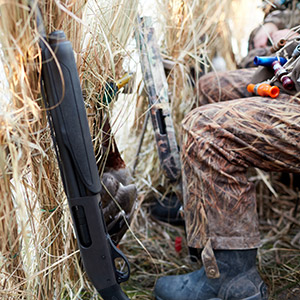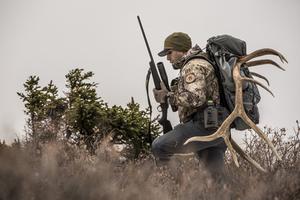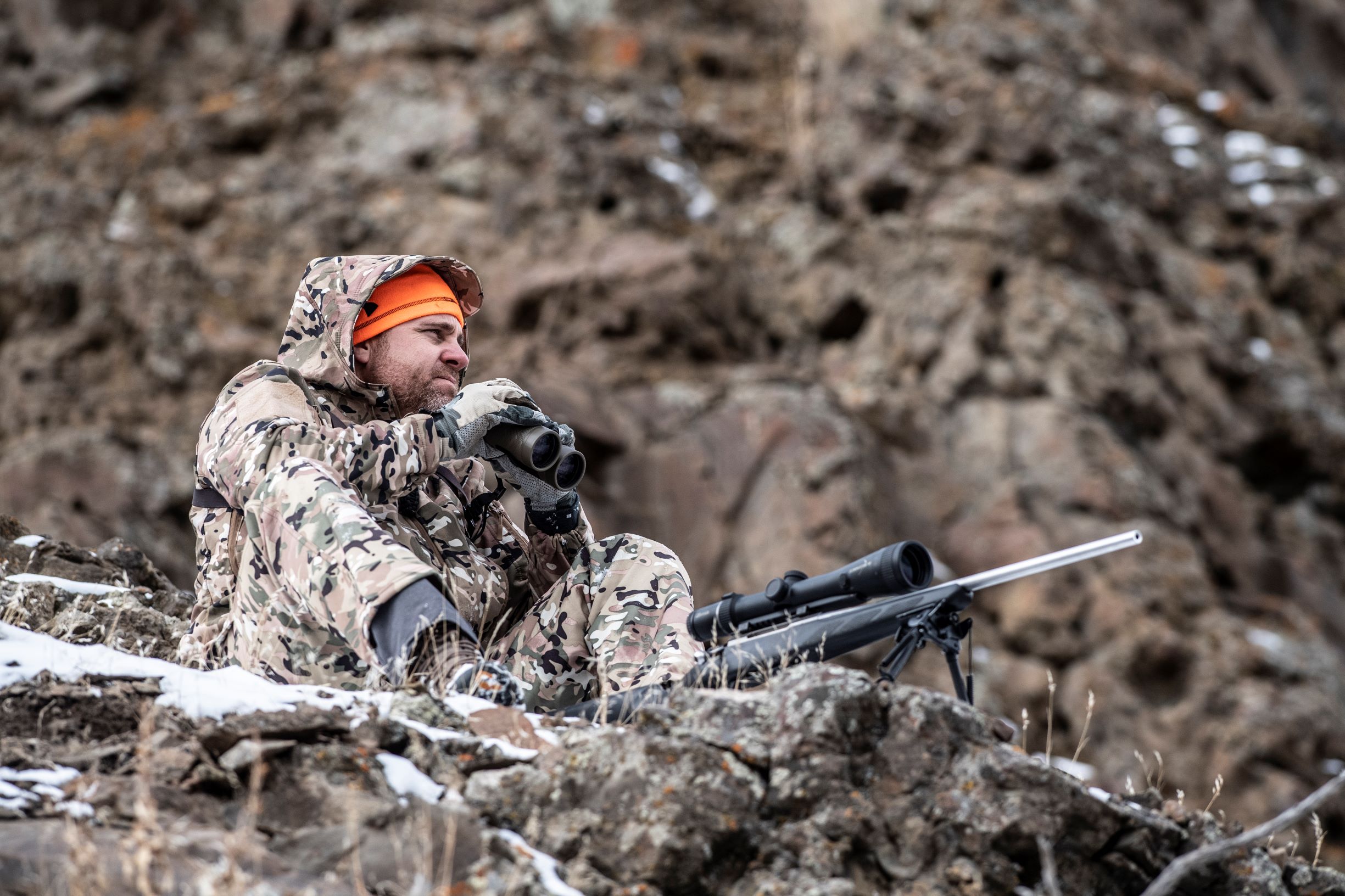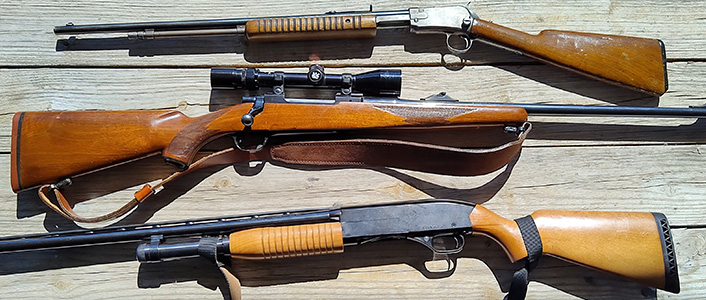
The author’s first guns that he’s still hunting with over 30 years later, in the order that he received them.
Top to bottom: Winchester Model 62A pump-action .22LR rifle, Ruger M77 scoped bolt-action .25-06 rifle, Winchester Model 1300 Youth pump-action 20-gauge shotgun.
On the surface, it seems like a simple question: “What are the best hunting guns?” Then everyone starts making the case for their preferred guns and the subjective opinions start flying around the gun counter (or internet).
People with all different levels of skill and experience will tell you with heartfelt authority that they would only go with A, B, C. Then the next person will scoff and say, “A, B, C could never match up to X, Y, Z, and here’s why …” If you’re new to hunting and firearms, choosing between A or X, B or Y, C or Z can be enough to make your head spin and your heart filled with doubt. Even after you make your purchase, that doubt can creep home with you, and then it follows you into the field. I’m going to try and make this contentious topic as easy as possible for you and do my absolute best to be objective and omit my personal preferences.
The truth is, there’s not really a one-size-fits-all answer to this age-old debate.
What Should You Check Before Choosing a Firearm for Hunting?
- Is Hunter’s Education required? Most states require Hunter’s Ed. before you can be issued a license. These are simple, informative courses that don’t take too much time to complete and can often be done online. These classes are affordable, informative, and a great way to figure out if hunting’s really for you before you spend a lot of money on a gun, ammo, and the endless other outfits and doodads that make up our hunting gear.
Make sure you enroll well ahead of hunting season, those who procrastinate until a couple of months before opening day often find that all of the courses are at capacity and they have to wait until after the season’s over. Hunter’s Ed. instructors are also hunters and are usually spending all of their spare time in the field instead of a classroom. In a nutshell, if you want to hunt next year start learning this year.
Pro tip: if you can get out in the field with an established hunter even before Hunter’s Ed., go for it! Without the proper license or tags, you won’t be personally harvesting an animal, but the things you can learn are invaluable. This is how those of us who grew up in hunting families learned, tagging along as kids to learn through observation and getting the hang of what it’s all about before it was our turn behind the gun. My old man was particularly fond of overloading me with gear like a pack mule so I’d learn what was essential and what’s better left in the truck. - What legal requirements when selecting a firearm for hunting? Is it legal to hunt with? Laws vary depending on what and where you want to hunt. Always check the current Fish & Game regulations to ensure you’re using a legal firearm and ammunition for the animals and area where you intend to hunt. 20-30 minutes on a government website can save you a lot of trouble should you encounter a conservation officer. This is something that’s best to check for yourself instead of relying on anyone but Fish and Game to make sure you know all of the applicable details.
- Is it appropriate to hunt with? Generally speaking, find out if it’s too overpowered or underpowered for what you want to hunt. If it’s designed for self-defense, law enforcement, or professional-level competitions, it may not necessarily be appropriate for hunting.
Just because it’s legal doesn’t mean it won’t be overkill or insufficient for the game you’re after. - Can you borrow one to try it out? Most experienced hunters are happy to bring along someone who wants to learn and are happy to share or lend a gun for a trip to the range or afield. However, they’ll be unlikely to lend it to you without being present due to safety concerns, liability issues, and general doting over their gun. Don’t take offense, they’re protecting you as much as themselves.
- Does it fit you? Start with simple questions: is it too big, long, or heavy for you to hold comfortably? Is it too complicated for your skill level? Is it too high-powered for you? Is the ammunition so expensive that you can’t afford it? Any of these factors can really put you off of hunting and make it an unpleasant experience.
Think of guns like shoes: if they don’t fit or are impractical, you’re not going to like them and they’ll just sit in the closet. Wouldn’t you be skeptical if we haven’t met and I just handed you my boots and told you to start walking? Try several on for size before plunking down your hard-earned money.
Best Hunting Guns | The “Holy Trinity of Hunting”
Old-timers have long held that any and all hunters must have 3 guns:
- A .22 Long Rifle
- A bolt-action .30-06
- A pump-action 12-gauge shotgun
This is what was passed down to me by my father from my grandfather. It’s been reiterated throughout my years of chatting on both sides of the gun counter, at hunting camps, shooting ranges, and gun shows. I’ve heard it to be a “fact” since I was a little kid tagging along on hunts. It’s carved in stone; it’s immutable truth. To claim otherwise is to be met with the bullhorns, pitchforks, and torches of the indoctrinated. They’re absolutely resolute, this is the “holy trinity of hunting”* forever and ever, amen.
Except it isn’t.
Before you scroll down to the comments to lambaste me, hear me out. Then scroll down and give me both barrels. I enjoy this debate.
Yes, the “holy trinity of hunting” is the most universal set of guns for hunting and are all very good to have. But “universal” implies “one-size-fits-all,” and when picking out your gun, that’s some flawed logic. Rather than “universal,” I like to focus on “versatility” when it comes to the guns I take out hunting.
I’m lucky enough to live in a place where there’s always something in season year-round, so I’m out in the field a lot with one or two different guns depending on what’s on the menu. If you don’t get to go out much, versatility is even more important to maximize each trip. If you’re on a budget, versatility becomes the most important consideration.
| RIMFIRE & CENTERFIRE DEFINED: |
|---|
| The firing pin strikes the primer on a gun’s ammunition, causing the powder to ignite and the pressure to push the projectile out of the end of the barrel. There have been various designs over the centuries, but today almost all of them are rimfire or centerfire. Blackpowder guns are still sometimes used for limited hunting, and their primers are separate pieces that have to be loaded manually for each shot. Rimfire simply means that the primer is in the rim on the bottom of the cartridge. A rimfire’s firing pin looks a bit like a small flathead screwdriver blade and can strike anywhere on the cartridge to set it off. It’s only common to very small calibers and appropriate for small game or target shooting. Centerfire means that the primer is a noticeable ring-shaped button on the bottom of the cartridge that ignites the gunpowder. “Centerfire rifle” is a commonly used term to differentiate them from rimfires, especially in hunting regulations. Except for some very small centerfire calibers, a lot of them are suitable for hunting mid-size to big game. Shotgun shells are all centerfires, so there’s no need to indicate a nonexistent distinction. |
The .22 Rimfire Round
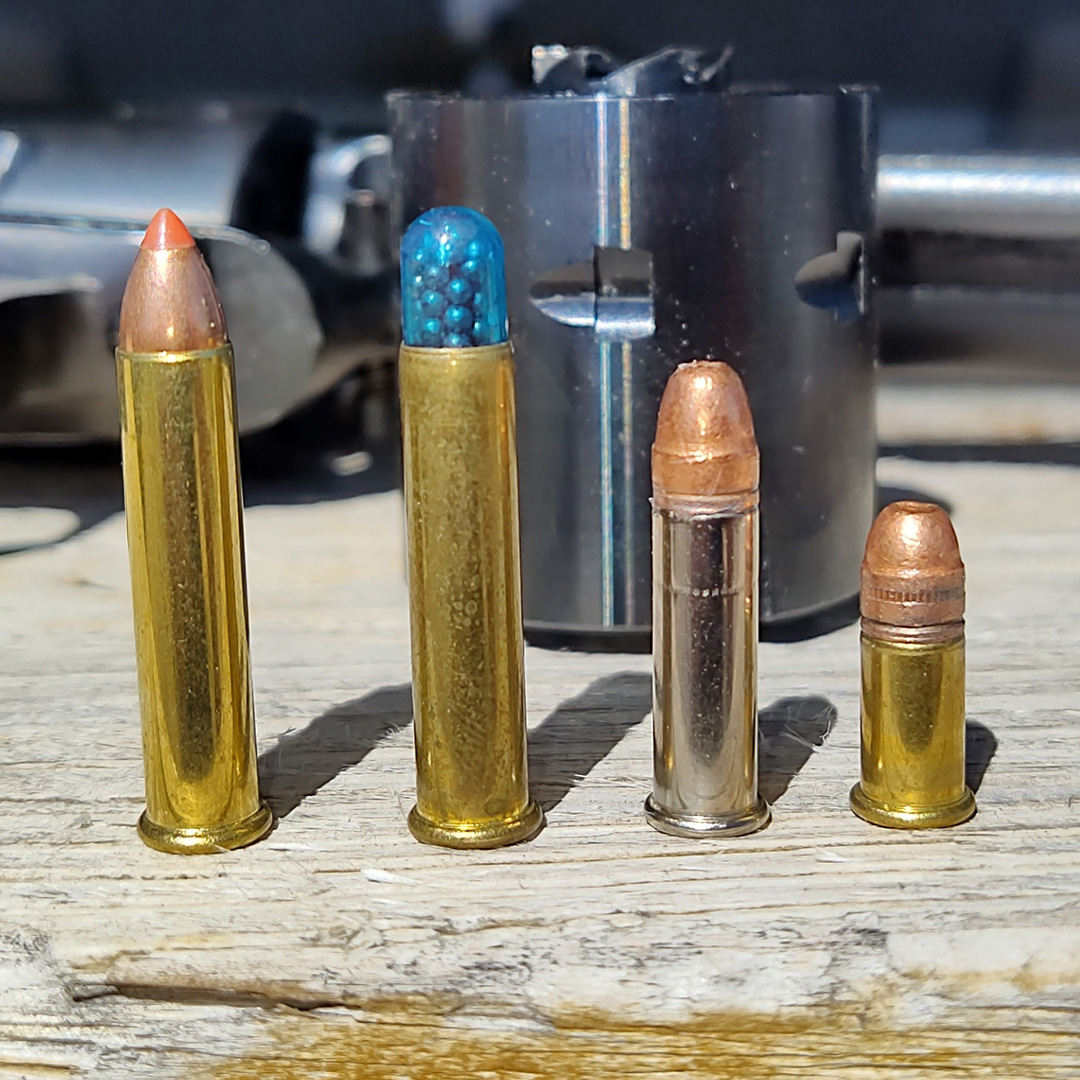
I’ll start with the most ubiquitous and popular caliber, and the one that introduces most of us to shooting: the .22 Long Rifle. In the late 19th century, this rimfire wonder was an evolution from its much smaller and less powerful “parlor gun” predecessors: the .22 BB Cap, the .22 CB Cap, the .22 Short, and the mostly obsolete .22 Long. In 1960, the .22 WMR (Winchester Magnum Rimfire) or “.22 Mag” came along. In the 21st century, several .17-caliber rimfires came into the market, all necked-down versions of .22 cartridges. Since those .17’s are less common, I’ll be talking about .22’s, but they’re good to be aware of and definitely have their place in the hunting sphere (and are ballistically superior to .22’s).
.22 LR’s are really good for a beginner hunting rifle, even though they’re somewhat limited since you can’t hunt big game or most birds with them. By far the most popular .22LR in America is the semi-automatic Ruger 10/22. They’re affordable, quality, versatile rifles that are made in the good ol’ United States of America. There are kits and parts from a wide range of manufacturers to swap out stocks, barrels, triggers, add scopes, etc. A lot of people buy a basic model and then tinker around until it’s exactly what they want.
I was 12 when my dad gave me my first gun, a .22 rifle. Much to my disappointment, it wasn’t a semi-auto, and it wasn’t even new. It was an old pump-action Winchester with a tube-fed magazine (unbeknownst to me, it was also on the rarer end of old guns). The benefits soon became clear, as this tube-fed manual action has a lot of advantages over the super-cool semi-auto Marlin Papoose I got two years later. Versatility was the key; I could shoot any kind of ammo from .22 Short to .22 LR, .22 shotshells, and ammunition of any level of quality. I still have that ol’ Winnie, I still hunt with it, and it’s taken more critters and varmints than any other gun I’ve ever owned.
A semi-auto is limited to only the cartridges it’s chambered for and can be finicky about feeding and cycling certain loads. Non-semi-autos that don’t have that limitation are manual actions:
- .22 revolvers (pictured), double-action or single-action
- Break-action (pictured)
- Pump-action (pictured)
- Lever-action
- Bolt-action (single-shot or tube-fed magazine)
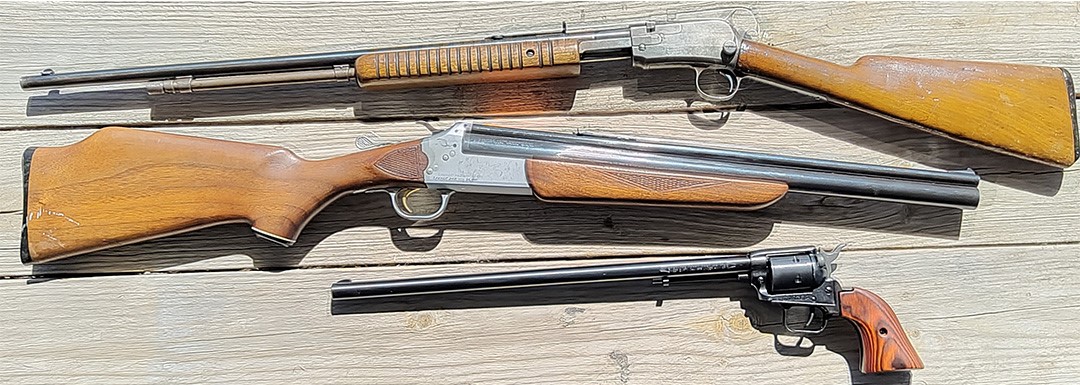
If you can only get one .22, consider a manual action. Some revolvers, like the Heritage Rough Rider 16” pictured, have interchangeable cylinders or parts to allow swapping from a .22LR to a .22 Mag. and increases the versatility depending on your needs and ammo on hand.
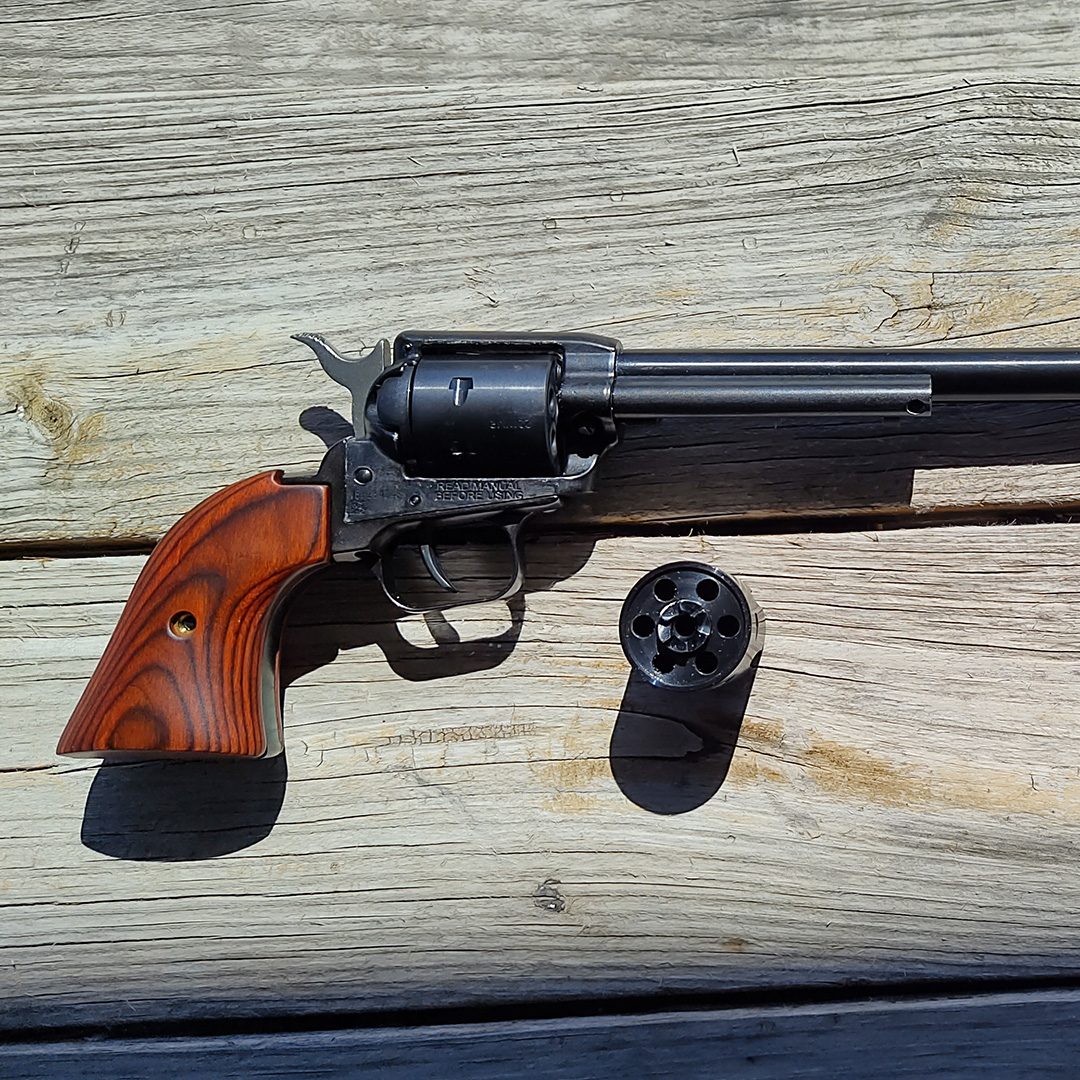
Short-barreled handguns aren’t very practical for hunting, but once you get around 5+ inches, they become more accurate and appropriate. Now is as good a time as any to point out that self-defense handguns are rarely suitable for hunting with their short concealable barrels, limited range, and calibers that are usually either underpowered or overkill. That’s not to say it can’t be and hasn’t been done; they’re just less practical in the field.
I’ll stand by the .22 Long Rifle being a must-have in your hunting toolkit for hunting small game and practicing marksmanship skills, no matter what action style you decide on. In these times of fluctuating ammunition availability, there’s also a case to be made for a high-powered air rifle as a backup to a rimfire. There are a lot of them on the market now that deliver 1,000+ fps (feet per second) muzzle velocity, which is plenty for hunting small game (where legal). They use pellets (sometimes BB’s), and .177 is the most air rifle common caliber, with .22 being a close second.
The Bolt-Action .30-06 (and Alternatives)
The venerable .30-06 Springfield has been used to take down every big animal in North America, including moose, bison, and grizzlies. It’s been a mainstay for hunters since the first commercially available model came out in 1908. A bolt-action is simple to use and very reliable in a variety of conditions. That’s exactly why you see most big game hunters using a scoped bolt-action in the field. That doesn’t make it the end-all-be-all big game rifle, though.

There are a host of other centerfire guns large and small that can be the “best hunting guns” for big game that could be a better fit for you. For the most part, it’s about shot placement for a clean kill above any other factor. I know people who hunt deer with a 5.56mm/.223 Rem because it’s what they have. I had a coworker who downed elk with an AR-10 using 7.62mm NATO because he was more comfortable with it than a bolt-action or any other rifle. He just used a 5-round magazine for easier handling in the woods and added an appropriate scope.
A .30-06 can be a little too much recoil for some folks, especially combined with a modern lightweight synthetic stock, and that can take them out of the running as good hunting guns for beginners, particularly for kids. My son’s first deer rifle was a compact break-action single-shot .243 Win that worked great for him. My first was the .25-06 bolt-action that has dropped plenty of deer and I still take it out at least once a year (pictured above).
People hunt with all kinds of other rifles like .270’s, .300 Win. Mag.’s, lever-action .30-30’s, .45-70’s, the list goes on and on. The 6.5mm Creedmoor is a relatively new cartridge that has really taken off in popularity and is more and more common out in the woods. The point is that there are a lot of hunting rifles to choose from for big game so there’s no all-time “best beginner hunting rifle” for everyone. It’s more about honing your shooting skills to focus on shot placement with the gun you have available and that suits you rather than “everyone’s favorite caliber.”
The Mighty Shotgun, Master of Versatility
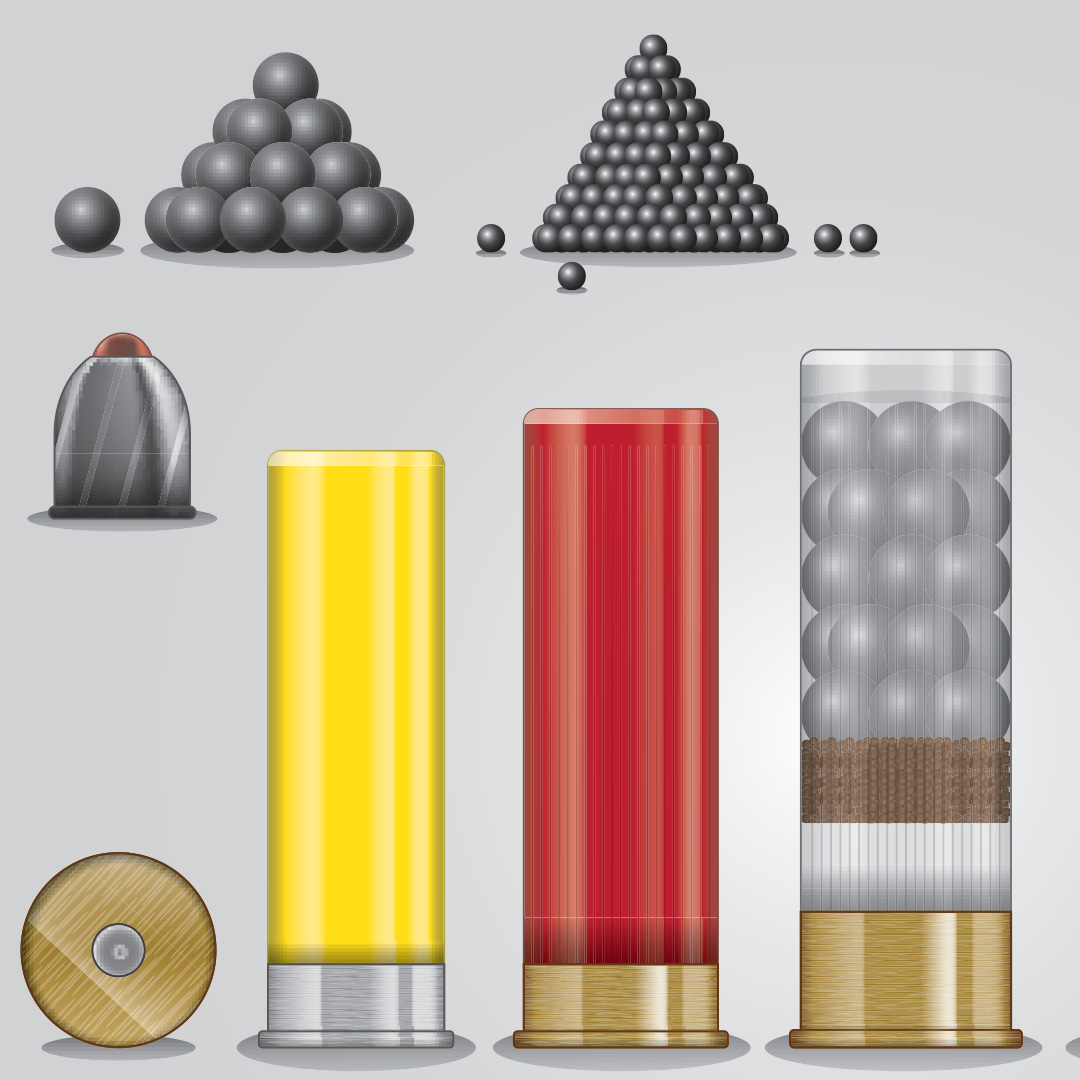
I’ve left the shotgun last for a reason: it’s hands-down the most versatile hunting gun you can have, and I believe that makes them arguably the best hunting guns. The reason a shotgun is so versatile is the sheer volume of different kinds of rounds you can use in them. “Shot” simply means a lot of small projectiles in one cartridge for a higher likelihood of hitting your target, especially a moving target, as opposed to a single projectile like a pistol or rifle. Shot sizes are tailored to different wild game: the smaller the game, the smaller the shot, and the bigger the game, the bigger the shot.
- For bigger animals like deer, there’s buckshot.
- There are also slugs, a single very large projectile made in rifled for smoothbores or sabot for rifled shotgun barrels.
- Some shells have a combo of different shot sizes in one, and some that combine slugs and shot.
- If you can imagine it, it’s probably been loaded into a shotgun at some point for whatever reason.
You’ll often hear people say, “If you can only get one gun, get a pump-action 12-gauge with interchangeable chokes.” That’s shorthand, though, and doesn’t take into account the fact that a 12ga can be too much gun for some people. I tend to say, “If you can only get one gun, get a shotgun that fits you.” They’re a great all-around gun since you can hunt everything from squirrels to big game with them, and they afford peace of mind as a home defense gun. Their range is far more limited than a centerfire rifle, but they’re powerful when used properly. Every kind of shotgun action from single-shot to semiautomatic is appropriate for hunting, but at the bare bones absolute minimum, it should have a shoulder stock and at least an 18-inch barrel with a modified choke.**
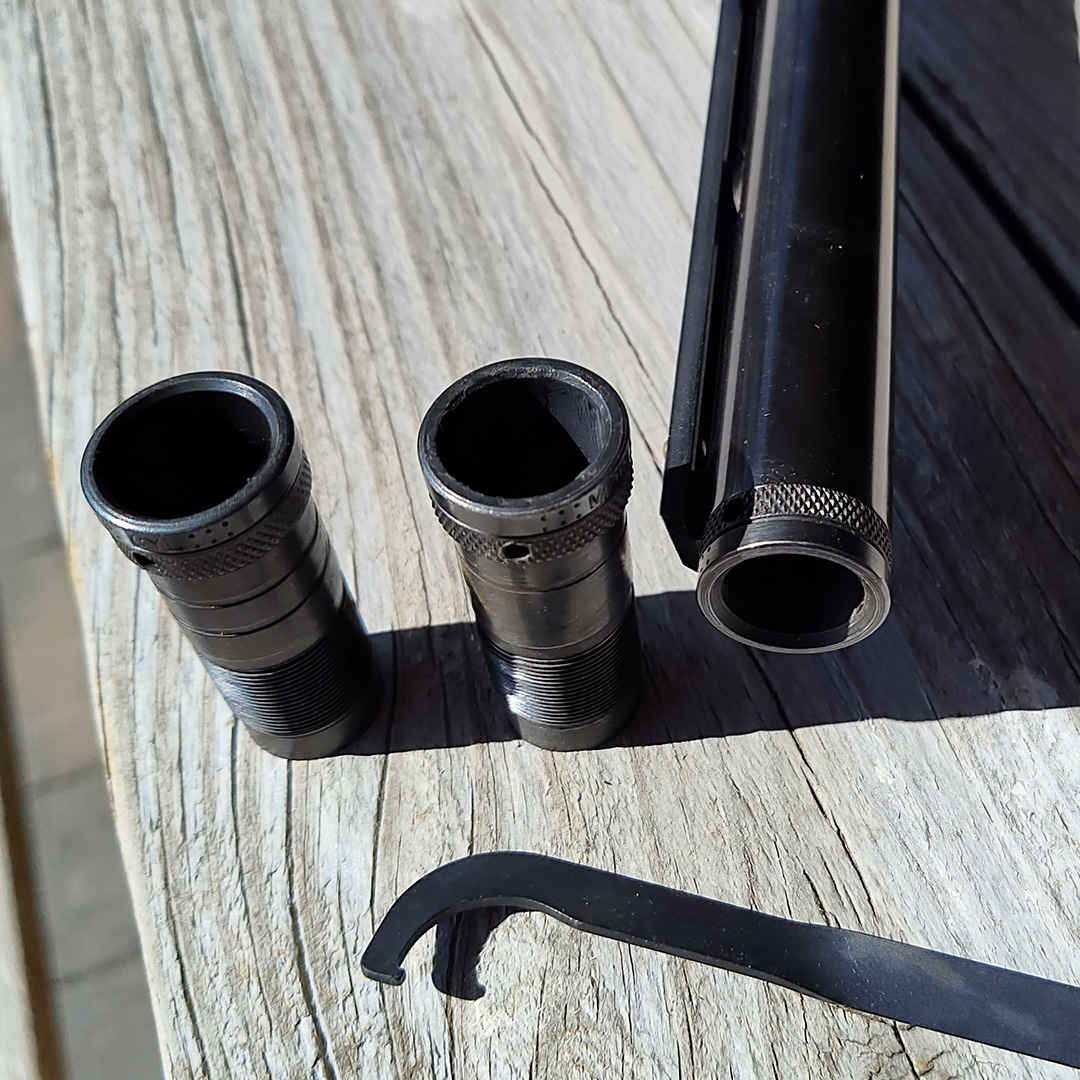
The “choke” refers to how constricted the end of the barrel is, determining if you’ll have a wide shot pattern or a more concentrated one. A fixed choke means the gun has a set pattern that can’t be changed without a trip to the gunsmith. An interchangeable choke tube is far preferable for a shotgun, as it allows you to change the pattern depending on your application and has far more versatility. The basic 5, in order from widest pattern to narrowest, are cylinder, improved cylinder, modified, improved modified, and full. There are too many other variations to list here, but they vary in design and function as much as shotgun ammo does.
Yes, the 12-gauge has a wide variety of ammo choices, but those choices are usually also available in 20-gauge or .410 bore, which are much more suited to smaller hunters and those who are recoil-sensitive. My first was a 20-gauge pump and, you guessed it, I still hunt with it every year. Less common in order from smallest to largest are the 28-gauge, 16-gauge, and 10-gauge. Since they’re not as popular as the other gauges, ammo can be harder to come by, but they’re all fun to shoot (the 10-gauge requires some fortitude).
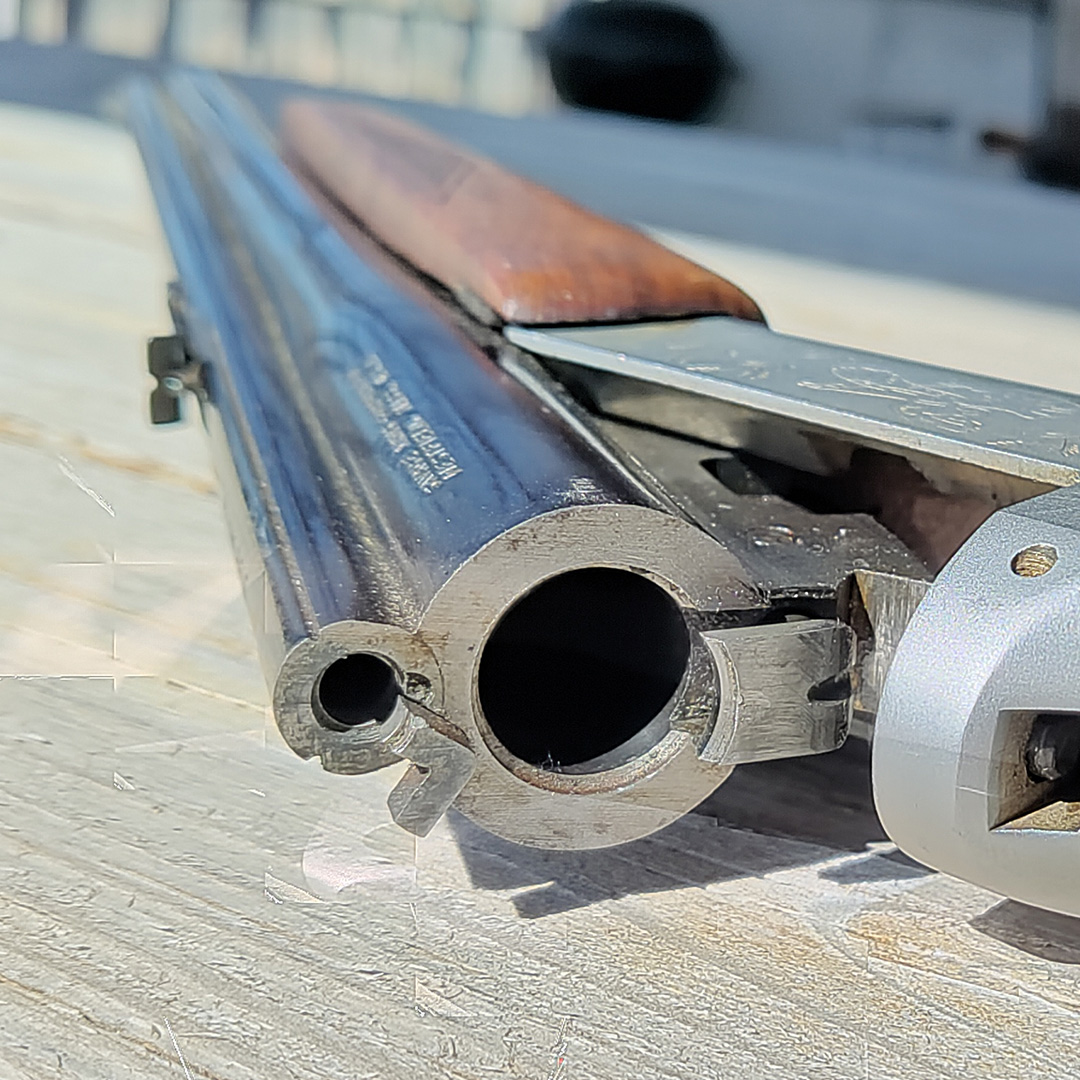
One nifty variation is the combo gun. Usually, this consists of a rifled barrel over a smoothbore shotgun barrel in a break-action, called an Over/Under (O/U). It’s pretty common to find them with a .22LR/.410 or .22LR/20ga, often billed as a “survival rifle.” Another is a .223 Rem./12ga, very handy for big game hunts where you might come across birds or other small game. There have been innumerable variants though, mostly European, including guns with 3 or 4 barrels in various calibers, known as a “drilling” and a “Vierling,” respectively. Personally, if I could only keep one of my guns for hunting, I’d stick with my Savage Diplomat in .22/20ga (pictured). It’s the most versatile firearm I’ve ever owned ammo-wise and I’ve hoofed a lot of miles turning quite a bit of fauna into food with it.
The Boiled-Down Basics of the “Best Hunting Guns”
So what should you check before choosing a firearm for hunting?
- It’s fair to say that a hunter should at least have a shotgun that suits them.
- If they can afford it, then a .22 Long Rifle would be second on the list.
- Lastly, getting serious about big-game hunting means getting a centerfire rifle in the size and caliber that is best for the hunter’s size and intended prey.
None of these necessarily has to be anything more than you need or can afford; just put in that practice time and you’ll do well when you go afield. Tell me what you think by leaving a comment below!
*Full disclosure: I have the “holy trinity of hunting” in my slightly excessive and ever-growing firearm collection that I’ve accumulated over the last 30-odd years. The vast majority of my guns are hunters, and each of them comes out with me at least once per season. Wall-hangers are great, but they don’t put food in the freezer.
**I’ve taken plenty of grouse with an 18” fixed cylinder choke barrel, it’ll do in a pinch.
- Do all 9mm bullets fit 9mm guns? 3 Popular 9mm Calibers - August 13, 2021
- Hot Weather Tips: 5 Easy Hacks - July 19, 2021
- The Bugout Bag and The Family Bugout Bag 101 - June 18, 2021
Related Posts
« Tactical Pants Materials: A Look at Fibers, Weaves and Finishes Long Range Shooting Tips: Understanding the Rifle, Scope & Skills »


